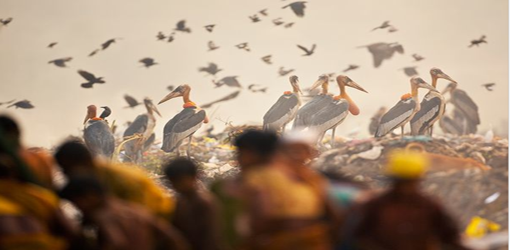Residents of the earth, opposed to rulers of it
Posted on December 5, 2011 | posted by:Clive Dilnot states that “Designing with consciousness for all of the parties involved becomes crucial, as the current environmental crisis blatantly emphasizes. Persons in relation to situation and context.” We are fascinated with the constant and meaningless desire for the newest thing, a race for the best and the latest, but yet in the end there is no winner. How do we begin to shift this detrimental behavior and become more ethical, more importantly how do we design more consciously?
A couple weeks ago we had the opportunity to get a glimpse of Natalie Jeremijenko’s universe, an eye-opening experience to say the least. Natalie is a renowned environmentalist, engineer, and activist who is not only reshaping the way think about science but also the art world. Natalie challenged us to think about the transaction between humans and non-humans and to create opportunities for new conversations and behavioural change. How do you start to think from a “non-human” perspective or is it even possible? Are we able to see beyond the bubble and outside of our cultural realm?
After finishing the project and getting some well-deserved sleep I started noticing how much the short-term project with Natalie impacted my thought process as a designer. The project brought up many questions concerning our notion of progress, the future and more importantly a realization of being. I soon realized a fundamental flaw in how we view the world as ours, something we possess, rather than us being residents of the earth. In many of the articles we discuss in class, as elsewhere, people refer to the planet as ours and not endearingly or as something we cherish or protect. When did this shift in thought occur? How do we as designers create that framework for ourselves and others to think responsibly and become more aware of our actions and choices?
After reading the life-altering book Ishmell by Daniel Quinn this idea of understanding the non-human perspective and thinking more holistically started to makes sense. It isn’t just about the way we act individually but rather as a civilization and as a collective. Quinn blames the deterioration and lack of respect for the earth on humanity itself. His science fiction novel sets up an interesting dynamic between a telepathic gorilla and a young man. The telepathic gorilla’s perspective is important because it allows us to empathize and relate to the non-human viewpoint. This perspective is also highlighted in one of Natalie’s projects called Bird Perch. When the bird lands on the perch it triggers an electronic device that speaks as if it was the bird speaking, which creates an interesting conversation with the humans bellow. Both Quinn and Natalie’s work focuses our attention on the non-human perspective, which allows us to understand and think critically about our relationship with non-human species.
The story of Ishmell starts out with the gorilla posting advertisement in the paper stating, “Teacher Seeks Pupil. Must have an earnest desire to save the world. Apply in person.” Out of curiosity a young man, lacking ambition and motivation in life decided he had nothing to loose and applied for the position. The story carries on with the gorilla teaching him the story of the human created ecological crisis from his perspective and how it all started when human civilization began. He claims this crisis occurred when humans essentially shifted from an indigenous lifestyle, which Quinn calls the ‘leavers,’ to the ‘taker lifestyle.’ The ‘taker lifestyle’ is our Western culture, a society fixated on consumption and material progress with little emphasis on our actions and the implications. The gorilla prompts the young man to think about the actions of Western culture. “Does being civilized make you incapable of giving the creatures around you a little space in which to live?” The man begins to realize how much our Western society takes for granted and how we don’t think in relation to the other species around us. Essentially, man thinks and acts as if the world was made for him and leaves little room for the other creatures whom we are sharing the planet with. Similarly to what Natalie Jeremijenko was trying to get us to understand through her work, such as the Bird Perch Project. We need to understand and think about the other non-human parties involved and the planet as a whole and not an object at our disposal.
The problem then becomes who should be informed the consumer or the producer? Searching for guilty parties is not the right solution. Collectively design can change behavioral patterns by being informed and understanding the agency for ethical choices. Both Natlalie Jeremijenko and Daniel Quinn challenge us to think about other the non-human species and to think holistically about the implications of the choices we make as producers and consumers. We must break out of this Western ideal and stop fighting over power and wealth within the bubble itself and rethink our actions completely.

